![]()
Aroids and other genera in the Collection
Take the Tour Now?
Orchids
The
Exotic Rainforest
Plants in
the Exotic Rainforest Collection
The images on this website are copyright protected. Please contact us before any reuse.
Detailed information on Growing Anthurium Species
Click this Link
The Exotic Rainforest is a private botanical garden.
Within our collection we have many species of Anthurium. If you are seeking other photos, click this link:
New: Understanding, pronouncing and using Botanical terminology, a Glossary
Anthurium hookeri
Kunth
The plant in your yard is probably
not
Anthurium
hookeri.
This article explains how to identify the true species which produces
white berries instead of red.
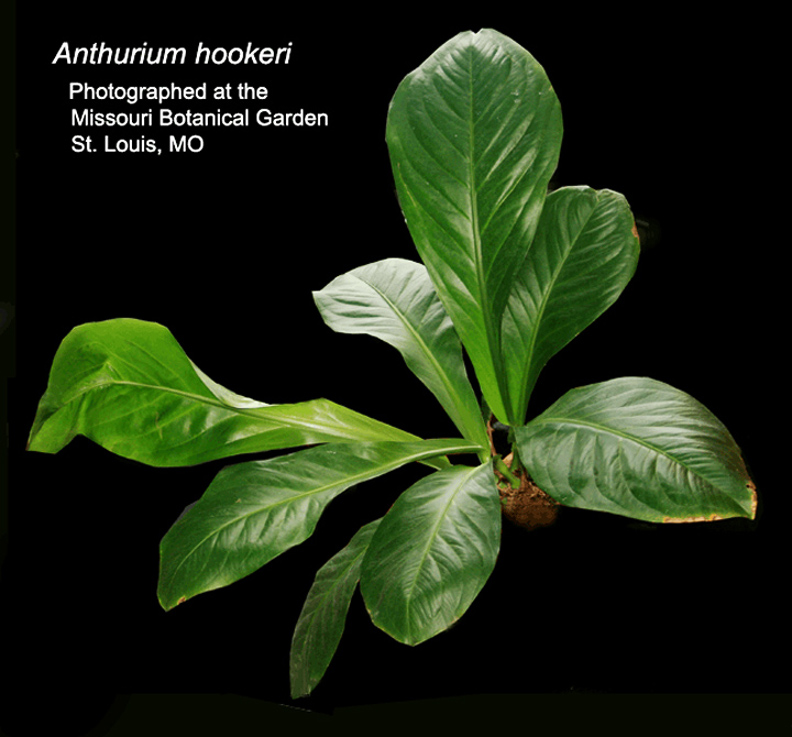
Anthurium hookeri
Kunth
Synonyms:
Anthurium huegelii, Anthurium
neglectum
The true Anthurium
hookeri is not the common Bird's Nest Anthurium found in South
Florida yards!
Sometimes incorrectly spelled
"Anthurium
hookerii"
Some of the photos
seen on this page are courtesy of aroid botanist
David Scherberich,
Jardin
Botanique de la Ville de Lyon,
France.
You can see David's aroid specimen photo gallery here:
http://www.aroidpictures.fr/pictures.html
The scientific data in this text was gathered from personal communication
including email and visits to the office of
aroid botanist
Dr. Thomas B. Croat. Other material was take from his journal
Annals of the Missouri Botanical Garden 1991, Volume
78, #3.
Although scientific terminology is used in this article an effort is
made to make that terminology understandable.
The goal of this discussion is to help you determine if you have the Anthurium species known to science as Anthurium hookeri or an unknown hybrid. If you read the details making a determination is often easy.
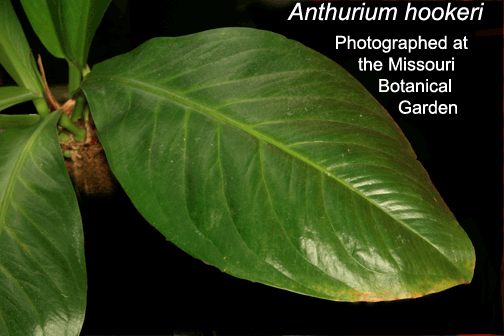 The name "Anthurium hookeri"
(or hookerii) is often incorrectly applied to hybridized Anthurium plants that are not related to the
species identified to science as Anthurium hookeri. It is
likely the vast majority of
specimens sold in South Florida aren't truly the species but instead
are hybrids "borrowing" using the name.
The name "Anthurium hookeri"
(or hookerii) is often incorrectly applied to hybridized Anthurium plants that are not related to the
species identified to science as Anthurium hookeri. It is
likely the vast majority of
specimens sold in South Florida aren't truly the species but instead
are hybrids "borrowing" using the name.
One
well known Florida nursery owner
stated,
"As many nurserymen down here know,
Anthurium hookeri is a catch all name applied to all bird nest type
Anthuriums regardless of true taxonomic origins."
Many of those hybrid plants are more closely related to Anthurium
schlechtendalii or Anthurium plowmanii than to Anthurium
hookeri. This article will help you determine if you are fortunate
enough to be growing the true Anthurium hookeri or a hybrid.
Unfortunately, and Denis explained, the name "hookeri" is now used more as a
common name, than the name of the species for which it ws originally
described.
The name Anthurium
hookeri is a true scientific name used incorrectly for almost any birds
nest Anthurium found used in
landscaping. The name "Anthurium hookeri" often represents the
very plant that is considered "tropical" in a Florida
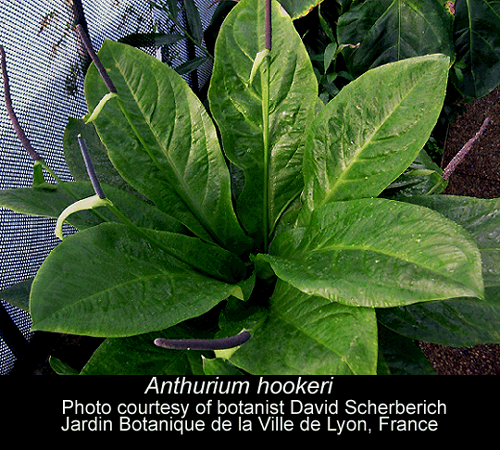 landscape
but regrettably that name is used for any plant that looks tropical rather than
being used for the true scientific species. I recently posted a
request on several garden discussion groups for anyone growing the true
species to post photos of their plant and not a single person responded.
landscape
but regrettably that name is used for any plant that looks tropical rather than
being used for the true scientific species. I recently posted a
request on several garden discussion groups for anyone growing the true
species to post photos of their plant and not a single person responded.
The term "tropical rain forest" was originated by German explorer Wilhelm Philipp Schimper when he first used the term in his 1898 book Plant Geography to describe the southeastern islands of the Caribbean where species such as Anthurium hookeri are found in nature. Schimper's definition of a rain forest was "evergreen, hygrophilous in character, at least 30 meters high, but usually much taller, rich in thick-stemmed lianas (jungle vines) and in woody as well as herbaceous epiphytes".
Many plant sellers sell any Anthurium they cannot identify using the generic name "Anthurium hookeri". The text you are reading is based on botanical science. Any collector should be able to use this material to determine if they are or not truly growing the Anthurium species known to science as Anthurium hookeri.
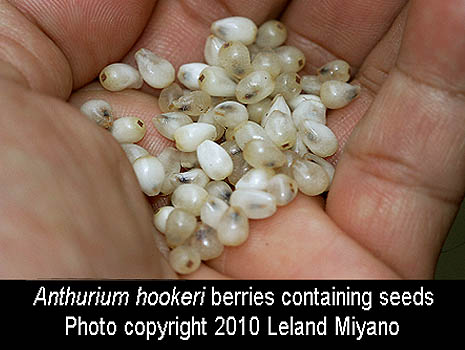 Anthurium hookeri is
relatively rare in nature and contrary to popular belief the berries
produced on a pollinated spadix (infructescence) are not red but
are instead white! The original scientific description stating the
berries are white as well as a botanically verified photo of an
infructescence by Dr. Croat (courtesy of the Missouri Botanical Garden
website TROPICOS) with white berries can be found on this page.
Anthurium hookeri is
relatively rare in nature and contrary to popular belief the berries
produced on a pollinated spadix (infructescence) are not red but
are instead white! The original scientific description stating the
berries are white as well as a botanically verified photo of an
infructescence by Dr. Croat (courtesy of the Missouri Botanical Garden
website TROPICOS) with white berries can be found on this page.
A variable Anthurium species, Anthurium hookeri was described to science by German botanist Carl Sigismund Kunth (1788 -1850). Many aroid species exhibit natural variation and not every leaf of every specimen will always look the same, however there are very distinctive characteristics which can be used to determine if a plant is, or is not the species, Anthurium hookeri Kunth.
Anthurium hookeri is an aroid and is found on many of the lower eastern Caribbean islands found in the West Indies including Dominica, Grenada, Guadeloupe, Montserrat, Nevis, St. Kitts, St. Lucia, St. Vincent, and Trinidad. It is also been observed in northern Venezuela and through the Guiana Shield in northeastern South America but is relatively rare in some of this region.
Although the record is not perfectly
clear, some anecdotal information implies the species was named in honor of Sir Joseph Dalton Hooker
(1817-1911) who was a well known 19th century botanist. Hooker described several taxa
(species) of aroids as well as a variety of other plant specimens including
the odd plant known on the internet as the Rare
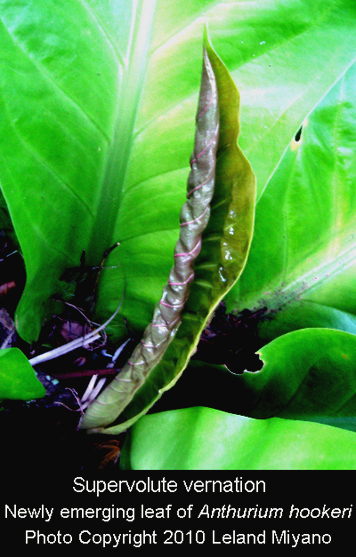 Thailand Parrot Flower (Impatiens
psittacina). Since the younger Hooker would have only been in his early 20's at the time
A. hookeri
was described it is likely Anthurium hookeri was named in honor of a
former director of the Royal Botanical Gardens, Kew in London botanist Sir
William Jackson Hooker (1785-1865) who was his father.
Thailand Parrot Flower (Impatiens
psittacina). Since the younger Hooker would have only been in his early 20's at the time
A. hookeri
was described it is likely Anthurium hookeri was named in honor of a
former director of the Royal Botanical Gardens, Kew in London botanist Sir
William Jackson Hooker (1785-1865) who was his father.
Anthurium hookeri grows both as an epiphyte (ep-a-FIT) and as a terrestrial Anthurium species. An epiphyte is a plant that grows upon another plant (normally a tree) as can be seen in botanist David Scherberich's photo at the top of this page. As his photo illustrates, Anthurium hookeri is often found growing on the branches of a tree. The species is found in nature at elevations between 200 to 1450 meters (700 to 4,750 feet.
Despite the recent demand in Indonesia and southeast Asia for specimens of Anthurium hookeri it is likely many if not most of the plants sold as with that name are not truly the species but are instead a hybrid plant of unknown heritage. Specimens with the name "Anthurium hookeri" are frequently sold in the United States as landscape plants and are commonly available at nurseries in southern Florida. Almost all of the specimens using the name "Anthurium hookeri" in the nursery trade are not the species known to science as Anthurium hookeri but are instead a hybrid plant. It appears likely those hybrids include Anthurium plowmanii as one of the hybrid parents due to the wavy (undulated) leaf edges.
Most Anthurium collectors
also assume
incorrectly Anthurium hookeri is one of the "bird's nest forms"
placed in Anthurium section Pachyneurium
. According to
aroid botanist Dr. Thomas B. Croat
Ph.D., P.A. Schulze Curator of Botany
at the Missouri
Botanical Garden in St. Louis, the true Anthurium hookeri is not a
member of Anthurium section
Pachyneurium due to several unusual
characteristics.
On page 755 of his journal Annals of the Missouri Botanical Garden 1991,
Volume 78, #3, Dr. Croat wrote, "Though
treated as a Pachyneurium by both Schott (1860) and Engler (1905), Anthurium
hookeri does not belong there. It differs from all species of Pachyneurium
by having supervolute vernation and leaf blades with scalariforme
secondary
venation and glandular punctations on the lower blade surface. It probably
belongs to its own section or is an unusual member of
sect. Porphyrochitonium."
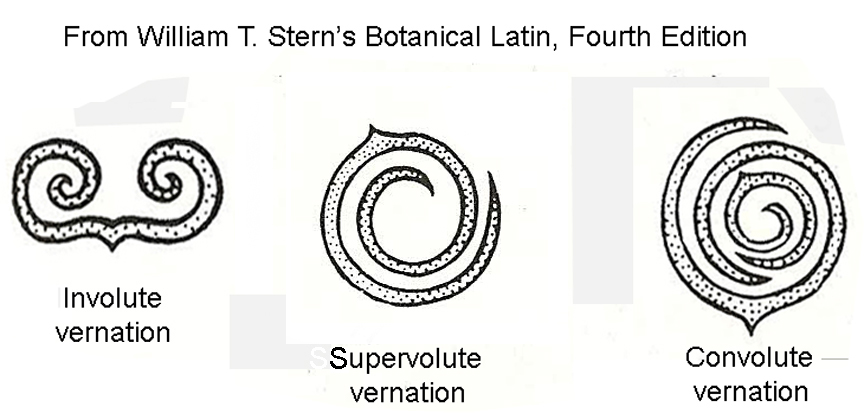
Supervolute is to possess coils or folds in overlapping whorls and vernation
refers to the arrangement of young leaf
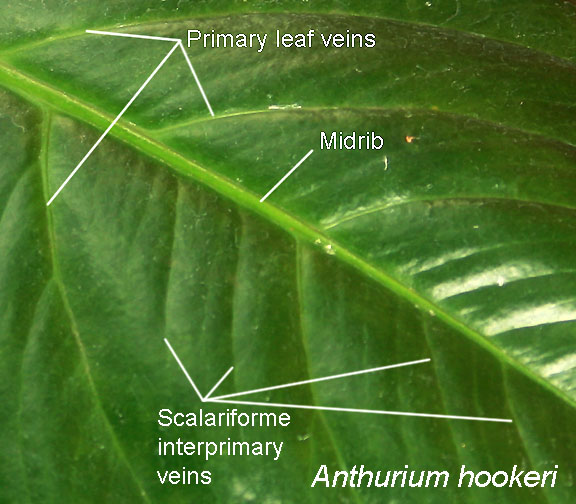 blades so supervolute vernation is
to possess a convolute arrangement in the folding or arrangement of a newly
emerging leaf blade with one margin (edge) of the newly blade emerging
rolled inward toward the midrib and the opposite margin rolled around the
midrib as well as the remainder of the leaf in a manner similar to the coil
at the end of a conch shell. The only difference in supervolute and
convolute vernation is convolute vernation occurs when several leaves spiral
with the
next leaf in a module enclosed within the current leaf. This will
be clearer if you look at the
drawing below. Anthurium hookeri does not
grow new leaves in the convolute fashion as do all members of section
Pachyneurium.
blades so supervolute vernation is
to possess a convolute arrangement in the folding or arrangement of a newly
emerging leaf blade with one margin (edge) of the newly blade emerging
rolled inward toward the midrib and the opposite margin rolled around the
midrib as well as the remainder of the leaf in a manner similar to the coil
at the end of a conch shell. The only difference in supervolute and
convolute vernation is convolute vernation occurs when several leaves spiral
with the
next leaf in a module enclosed within the current leaf. This will
be clearer if you look at the
drawing below. Anthurium hookeri does not
grow new leaves in the convolute fashion as do all members of section
Pachyneurium.
In another personal email he
continued,
"I personally think that it is in a new section of its own. It differs from
any other section in having scalariforme
e veins and glandular punctations. We
had hoped that molecular studies would help to sort out some of these
questions but the last I heard my student Monica had not really gotten good
resolution on all the sections."
Monica is researcher Monica
Carlsen.
scalariforme
venation
is used to describe the spacing of the interprimary or secondary veins that
extend in a roughly parallel or ladder-like fashion between the
primary lateral veins. The primary lateral leaf veins are the large
veins that run from the midrib to the edge (margin). The botanical term glandular punctations refers to tiny black dots found on the
underside (abaxial surface) of any leaf blade. For a better
understanding of glandular punctates please refer to David's photo (left, below).
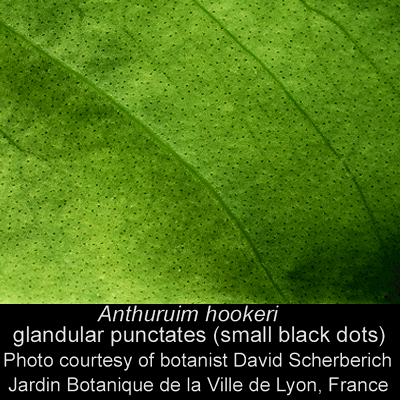 This message from Dr. Croat to the
members of the discussion forum Aroid l posted on December 17, 2001 offers a positive way to determine if a
specimen is truly Anthurium hookeri, "Anthurium
hookeri, which has scalariforme
This message from Dr. Croat to the
members of the discussion forum Aroid l posted on December 17, 2001 offers a positive way to determine if a
specimen is truly Anthurium hookeri, "Anthurium
hookeri, which has scalariforme
veins (ladder-like) extending between the
primary lateral
veins. You can definitively prove it one way or the
other though. If your plant has tiny black glandular dots on the lower
surface and/or if it has supervolute vernation (rather than involute
vernation) it is A. hookeri. If it lacks either it is a member of
Anthurium section Pachyneurium series
Pachyneurium."
Aroid expert Julius Boos explains further regarding supervolute vernation, "Supervolute vernation is the way the very young emerging leaves are 'folded', (see page 347 of Deni Bown`s book Aroids, Plants of the Arum Family to see what involute vernation looks like. Check this on most of your birds nest Anthurium sp., very interesting when you notice it for the first time. Supervolute vernation is very much like what Deni calls convulute vernation which is what Anthurium hookeri has and what makes it different from all other birds nest Anthuriums, all of which Tom says have involute vernation." (see drawing above)
The lack of the glandular
punctations (dots) and evenly spaced "ladder like" veins precludes many of
the specimens in collections as well as in Florida landscapes from being Anthurium hookeri. According to the
scientific description as well as Dr. Croat, the berries are whitish, not
red.
That information alone rules out many of the plants which commercial growers
often sell with the incorrect name "Anthurium hookeri".
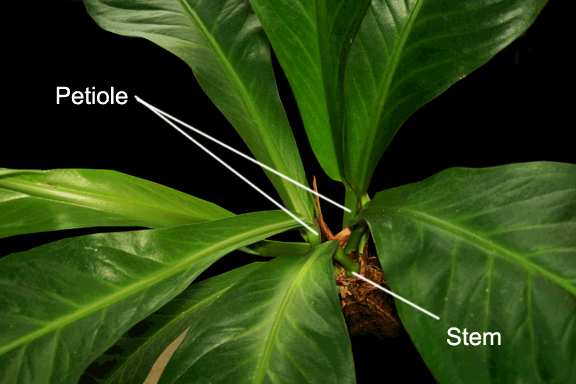 In his journal Annals of the
Missouri Botanical Garden 1991, Dr. Croat comments that the frequency of the
species in the wild in unknown. In personal conversation Dr. Croat has
indicated Anthurium hookeri may be somewhat rare, at
least in
the Guiana Shield region of South America.
I once asked my friend Dutch naturalist Joep Moonen (pronounced yupe) for
additional information on the species since he lives and works in the rain forests of French Guiana.
Joep often takes botanists into the jungle in search of rare and unusual
specimens. In his response Joep made this remark,
"I collected A. hookeri (I think) only in
South Suriname in 1983 at an inselberg at 2000 feet high. I do not think
the species lives in lowland forests, perhaps it is too hot. I will ask
people that go to
Martinique to look for them."
In
a follow-up message, Joep continued,
"I have never seen one on our excursions or
expeditions in the Guianas apart from an expedition in 1983 to the very
south of Suriname."
An inselberg is defined as
a
In his journal Annals of the
Missouri Botanical Garden 1991, Dr. Croat comments that the frequency of the
species in the wild in unknown. In personal conversation Dr. Croat has
indicated Anthurium hookeri may be somewhat rare, at
least in
the Guiana Shield region of South America.
I once asked my friend Dutch naturalist Joep Moonen (pronounced yupe) for
additional information on the species since he lives and works in the rain forests of French Guiana.
Joep often takes botanists into the jungle in search of rare and unusual
specimens. In his response Joep made this remark,
"I collected A. hookeri (I think) only in
South Suriname in 1983 at an inselberg at 2000 feet high. I do not think
the species lives in lowland forests, perhaps it is too hot. I will ask
people that go to
Martinique to look for them."
In
a follow-up message, Joep continued,
"I have never seen one on our excursions or
expeditions in the Guianas apart from an expedition in 1983 to the very
south of Suriname."
An inselberg is defined as
a
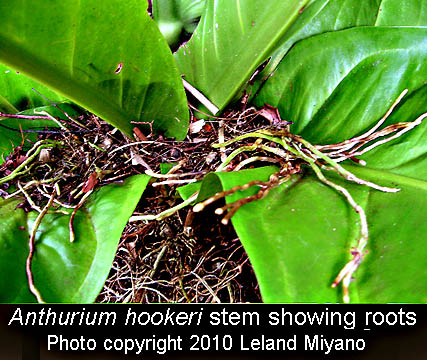 ridge or hill that remains
when a mountain erodes and is otherwise a flat plain.
ridge or hill that remains
when a mountain erodes and is otherwise a flat plain.
The leaf blades of Anthurium hookeri are oblanceolate (both oblong and lance shaped but wider near the tip) and can be up to 89cm long (roughly 3 feet). The leaves are widest just above the middle of each blade. The leaf margins (edges) are smooth and do not possess the ruffled edges most of the hybrid forms sold as "Anthurium hookeri" possess. The leaves are thick and leathery to the touch (coriaceous) and the leaf blades have 9 to 15 primary lateral leaf veins on each side of the leaf while the minor veins (tertiary) grow roughly parallel to the primary veins. Black glandular punctates (similar to small "dots") can be seen on the undersides of the leaf as is shown by David Scherberich photo (above left) but are also vaguely visible on the upper (adaxial) leaf surface.
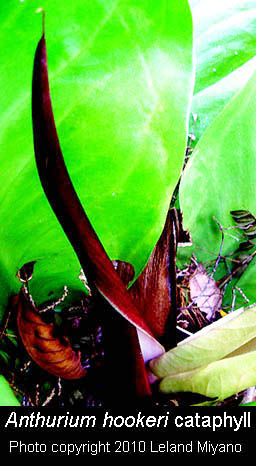 According to the scientific description
of Anthurium hookeri (see that document at the bottom of this page),
A. hookeri has roots that are very dense and the internodes
are short. An
internode is a segment of the stem between
two nodes while the nodes are where leaves may emerge. In botany
the stem is not the support for any single leaf
as is often stated by
collector/growers but instead is the base of the plant. Instead, the petioles support the leaf blades.
The petioles of Anthurium hookeri should be triangular to "D" shaped
when cut and viewed as a cross section (see illustration below left).
According to the scientific description
of Anthurium hookeri (see that document at the bottom of this page),
A. hookeri has roots that are very dense and the internodes
are short. An
internode is a segment of the stem between
two nodes while the nodes are where leaves may emerge. In botany
the stem is not the support for any single leaf
as is often stated by
collector/growers but instead is the base of the plant. Instead, the petioles support the leaf blades.
The petioles of Anthurium hookeri should be triangular to "D" shaped
when cut and viewed as a cross section (see illustration below left).
The cataphylls, which are a bract-like modified leaf that surrounds any
newly emerging leaf blade and whose purpose is to protect that new leaf
blade, are lanceolate (lance shaped) and typically
measure 20
to 26cm in length (7.8 inches to 10.25 inches) but may be
much smaller on
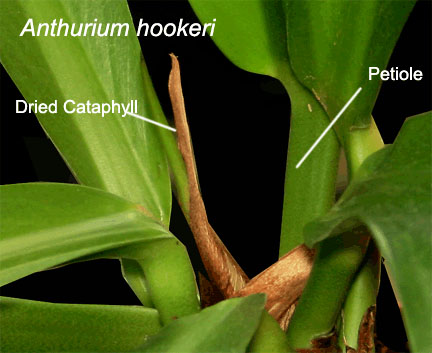 a young specimen. The leaf blades of Anthurium hookeri grow in a rosette cluster
(similar to the shape of a rose) and are somewhat similar to the birds nest forms. However, Anthurium hookeri is scientifically not a
member of section Pachyneurium which contains the birds nest Anthurium
species.
a young specimen. The leaf blades of Anthurium hookeri grow in a rosette cluster
(similar to the shape of a rose) and are somewhat similar to the birds nest forms. However, Anthurium hookeri is scientifically not a
member of section Pachyneurium which contains the birds nest Anthurium
species.
The actual section placement for Anthurium hookeri is still under scientific study however this
message from Dr. Croat helps to explain the current research,
"I
personally think that
it is in a new section of its own. It differs from any other section in
having scalariforme
veins and glandular punctations. We had hoped that
molecular studies would help to sort out some of these questions but the
last I heard my student Monica had not really gotten good resolution on all
the sections."
An
aroid, all Anthurium species reproduce via the production an
inflorescence. The stalk that supports the entire inflorescence is the
peduncle. When an Anthurium is "in flower" the reference is to the
tiny flowers containing both male
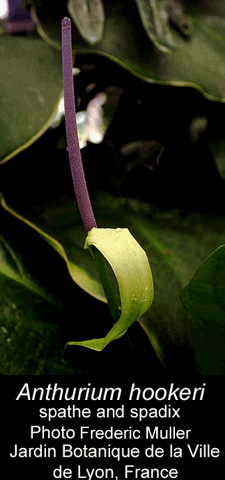 and female sexual parts that grow on the
spadix at the center of the inflorescence. Unlike plants in the genus
Philodendron which contain imperfect flowers having only a single sex
Anthurium possess perfect flowers containing both sexes. To help
prevent self pollination nature has designed the female flowers to be
receptive before the male portion of the flower produce their pollen so in
most cases an insect must bring pollen from another plant.
and female sexual parts that grow on the
spadix at the center of the inflorescence. Unlike plants in the genus
Philodendron which contain imperfect flowers having only a single sex
Anthurium possess perfect flowers containing both sexes. To help
prevent self pollination nature has designed the female flowers to be
receptive before the male portion of the flower produce their pollen so in
most cases an insect must bring pollen from another plant.
An aroid is a
plant that reproduces by growing an inflorescence which in an aroid
is known to science
as a
spathe and spadix. Most people believe the spathe is a
"flower" which is incorrect. The spathe is a modified leaf
whose purpose is to offer protection to the spadix at the center of the
inflorescence. During sexual anthesis there can be found very tiny
flowers on the spadix when the plant is ready to produce seeds. When
ready to reproduce the spadix grows In to
produce seeds the female portion of the flowers must first be pollinated when
they reach their own sexual
anthesis. The male
flower portion produce pollen after the female flowers are receptive and If the
female flowers are pollinated by an appropriate
Cyclocephala
beetle which carries pollen from another
Anthurium
specimen already at male anthesis those female
flowers will be pollinated
and the spadix will begin to grow white berries containing 1 to 2 seeds.
Anthurium hookeri produces an unimpressive inflorescence which hangs
spreading and pendent
(downward) alongside the bluish spadix and the spadix stands erect. The spathe is green
with a purple tinge and is cylindrically tapered. The seed berries found on
the infructescence are oval
and oblong in shape and not red
as is commonly believed.
Anthurium species are
known to be highly variable and not every leaf of every specimen will always
appear the same but
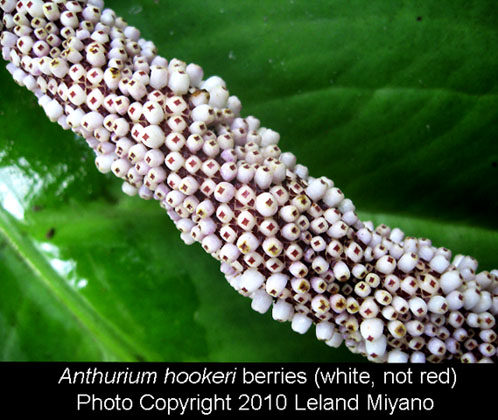 the sexual characteristics remain stable. This
link explains in greater detail the scientific principle of natural
variation and morphogenesis.
Natural variation
the sexual characteristics remain stable. This
link explains in greater detail the scientific principle of natural
variation and morphogenesis.
Natural variation
Many websites and sellers sell their hybrid specimens as
"Anthurium hookerii" (with
two i's) which is not a correct scientific spelling. There are
also firms that sell a plant they call "Anthurium hookeri
Ruffles". Scientifically, there is no such species and the common
name Anthurium Ruffles is more frequently applied Anthurium plowmanii.
Anthurium plowmanii commonly has ruffled edges but is
not closely related to Anthurium hookeri. The two species are found
thousands of miles apart in nature. There is another tissue cultured plant
sold as Anthurium
hookeri Marie which is a hybrid and does not appear to be related to
Anthurium hookeri.
A hybridized specimen is not the same as a scientific species since a hybridized plant has been genetically modified by combining the DNA of two or more species.
Anthurium hookeri prefers high humidity. Normally found growing as an epiphyte it also needs very fast draining soil to prosper since epiphytes typically do not have their roots in soil. Instead, the roots are simply attached to the host tree and suspended in the air. Grow this species in fast draining soil that will not remain soggy.
We have a specimen we had thought for many years to be Anthurium hookeri but the plant is not truly the species. Our specimen was formally a resident of the now defunct Orchid Jungle Park south of Miami, FL and was rescued by a grounds keeper after Hurricane Andrew destroyed the park in 1992.
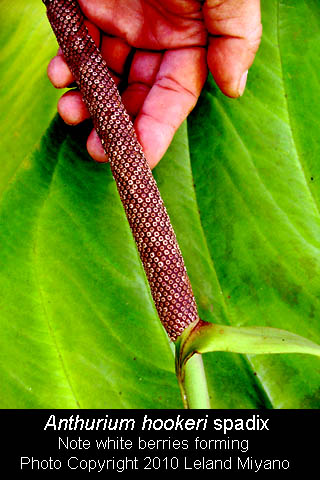 The absence of the "black dots", evenly spaced ladder-like
interprimary or secondary veins as well as
the production of red berries instead of white along with other
characteristics has proven our plant is not Anthurium hookeri
but instead Anthurium schlechtendalii. If the majority of
collectors that believe they are growing "Anthurium hookeri" were to check
these characteristics against their plant many will be very surprised at the
results.
The absence of the "black dots", evenly spaced ladder-like
interprimary or secondary veins as well as
the production of red berries instead of white along with other
characteristics has proven our plant is not Anthurium hookeri
but instead Anthurium schlechtendalii. If the majority of
collectors that believe they are growing "Anthurium hookeri" were to check
these characteristics against their plant many will be very surprised at the
results.
My thanks to Emily Colletti who is the chief aroid keeper at the Missouri Botanical Garden in St. Louis for her help in photographing specimens in the garden's collection. My additional thanks to botanist David Scherberich, Windy Aubrey, my mentor Dr. Tom Croat as well as aroid expert Leland Miyano for the use of their photographs of specimens of Anthurium hookeri.
David is associated with the Jardin Botanique de la Ville de Lyon, Parc de la Tete d'Or, Lyon, France. For those who don't speak French, the name is Lyon Botanic Garden.
My additional thanks to aroid botanist Dr. Tom Croat of the Missouri Botanical Garden for his counsel as well as providing the scientific description of the species along with detailed information during our research of this species.
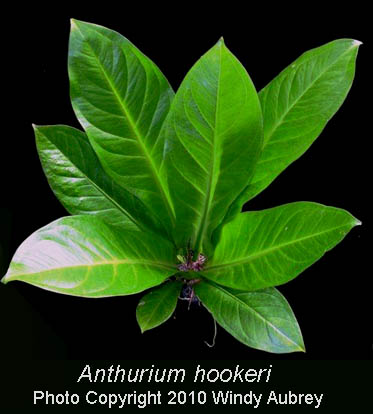
This is the scientific description of Anthurium hookeri published in 1841:
A. hookeri Kunth, Enum. pl. 3:74. 1841. Type: Schott Drawing 517 serves as the lectotype (designated by Mayo, 1982)
Epiphyte.
Internodes short, densely rooted; cataphylls lanceolate, 20-26 cm
long, dilacerating from base. VERNATION- supervolute; Leaves rosulate;
petioles triangular to D-shaped, 2-9 cm long, 1.5-1.7 cm wide; blades
oblanceolate, broadest above middle, margins smooth, black glandular
punctate on both surfaces, 35-89 cm long, 10-26 cm wide. primary
lateral veins 9-15 per side, free to the margin, tertiary veins
extending in a more or less parallel, ladder-like fashion between the
primary lateral veins (scalariforme
). peduncle to 47 cm long, to 5 mm
diam.; spathe pale green, tinged purple, oblong, to 9 cm long, to 1.5 cm
wide; spadix violet-purple, cylindroid-tapered, to 10-16 cm long, to 5-7
mm diam,; Infructescence- berries, obovoid, whitish, to 6 mm long, to
4.5 mm wide.
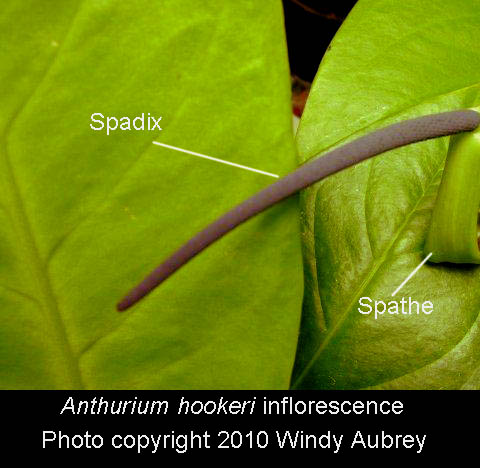
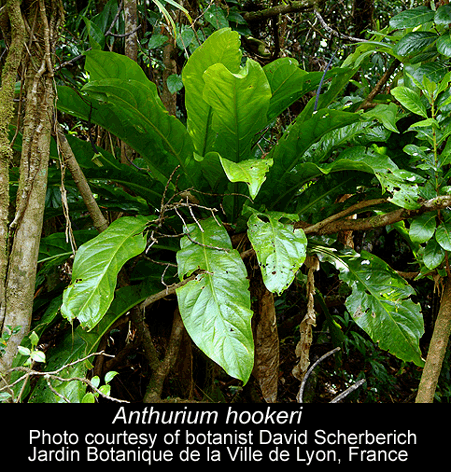
Aroid Pollination!
As
it occurs in nature and by any horticulturist
Join the International Aroid Society: http://www.exoticrainforest.com/Join%20IAS.html
Need more information on Anthurium species?
Click this link.